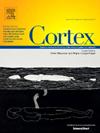预测非典型阿尔茨海默病纵向临床衰退的基线多模态成像。
IF 3.2
2区 心理学
Q1 BEHAVIORAL SCIENCES
引用次数: 0
摘要
在典型的阿尔茨海默病中,有公认的神经影像感兴趣区,这些感兴趣区已被用于跟踪疾病进展和帮助预后。然而,目前还需要经过验证的基线成像标记来预测非典型阿尔茨海默病的临床衰退。为了满足这一需求,我们使用惩罚回归法根据基线成像特征建立模型,并评估其对各种临床指标的预测性能。基线多模态成像数据与两个时间点的临床测试数据相结合,用于生成我们的模型,这些数据来自 46 名诊断为对数开放性进行性失语(24 人)或后皮质萎缩(22 人)的非典型阿尔茨海默病患者。另外 15 例患者(对数开放性进行性失语症 = 7 例,后部皮质萎缩 = 8 例)的数据未用于我们最初的分析,这些数据被用于检验我们的模型。患者在两个时间点接受了 MRI、FDG-PET 和 Tau-PET 成像检查和全面的神经系统检查。Schaefer 功能图谱用于从基线成像中提取基于网络的区域灰质体积或 PET SUVR 值。在控制基线表现、教育程度、年龄和性别的情况下,我们使用惩罚回归(Elastic Net)建立模型来预测第 2 个时间点的测试得分。此外,我们还使用临床或 Meta 感兴趣区域 (ROI) 数据创建了模型,作为比较。我们发现,在控制所有三种成像模式的上述指标的情况下,神经成像的基线受累程度可预测认知测试的未来表现。在许多情况下,将基于网络的神经成像数据添加到临床数据中后,模型的可预测性得到了提高。我们还发现,与仅由临床数据或 Meta ROI 评分组成的对比模型相比,我们基于网络的模型表现更为出色。从基线时间点的成像研究中创建与临床诊断无关的预测模型,就像我们所描述的那样,在临床和研究环境中,尤其是在未来疾病调整疗法的开发和实施中,可能会被证明是非常有价值的。本文章由计算机程序翻译,如有差异,请以英文原文为准。
Baseline multimodal imaging to predict longitudinal clinical decline in atypical Alzheimer's disease
There are recognized neuroimaging regions of interest in typical Alzheimer's disease which have been used to track disease progression and aid prognostication. However, there is a need for validated baseline imaging markers to predict clinical decline in atypical Alzheimer's Disease. We aimed to address this need by producing models from baseline imaging features using penalized regression and evaluating their predictive performance on various clinical measures.
Baseline multimodal imaging data, in combination with clinical testing data at two time points from 46 atypical Alzheimer's Disease patients with a diagnosis of logopenic progressive aphasia (N = 24) or posterior cortical atrophy (N = 22), were used to generate our models. An additional 15 patients (logopenic progressive aphasia = 7, posterior cortical atrophy = 8), whose data were not used in our original analysis, were used to test our models. Patients underwent MRI, FDG-PET and Tau-PET imaging and a full neurologic battery at two time points. The Schaefer functional atlas was used to extract network-based and regional gray matter volume or PET SUVR values from baseline imaging. Penalized regression (Elastic Net) was used to create models to predict scores on testing at Time 2 while controlling for baseline performance, education, age, and sex. In addition, we created models using clinical or Meta Region of Interested (ROI) data to serve as comparisons.
We found the degree of baseline involvement on neuroimaging was predictive of future performance on cognitive testing while controlling for the above measures on all three imaging modalities. In many cases, model predictability improved with the addition of network-based neuroimaging data to clinical data. We also found our network-based models performed superiorly to the comparison models comprised of only clinical or a Meta ROI score.
Creating predictive models from imaging studies at a baseline time point that are agnostic to clinical diagnosis as we have described could prove invaluable in both the clinical and research setting, particularly in the development and implementation of future disease modifying therapies.
求助全文
通过发布文献求助,成功后即可免费获取论文全文。
去求助
来源期刊

Cortex
医学-行为科学
CiteScore
7.00
自引率
5.60%
发文量
250
审稿时长
74 days
期刊介绍:
CORTEX is an international journal devoted to the study of cognition and of the relationship between the nervous system and mental processes, particularly as these are reflected in the behaviour of patients with acquired brain lesions, normal volunteers, children with typical and atypical development, and in the activation of brain regions and systems as recorded by functional neuroimaging techniques. It was founded in 1964 by Ennio De Renzi.
 求助内容:
求助内容: 应助结果提醒方式:
应助结果提醒方式:


